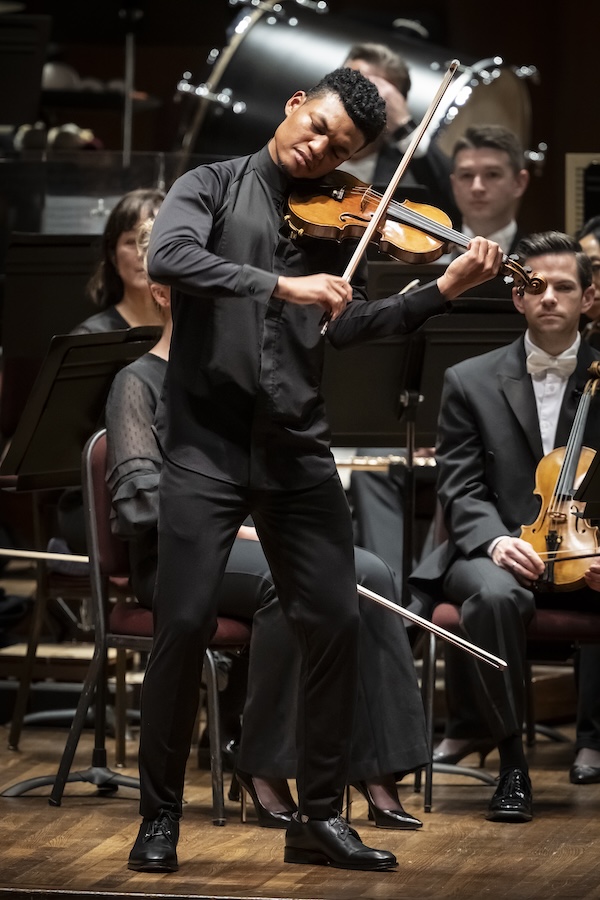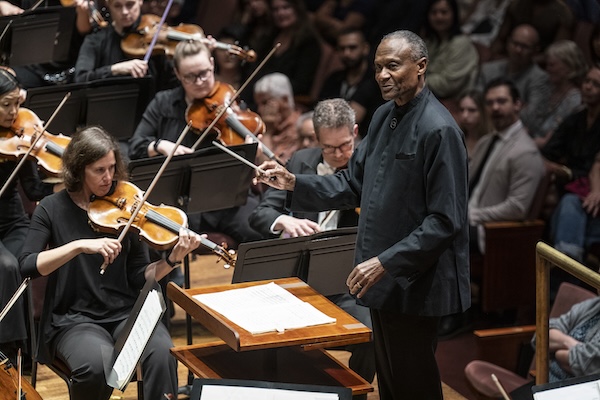Wilkins’ organic NSO program serves up a stimulating mix of old and new

Randall Goosby performed Mendelssohn’s Violin Concerto with Thomas Wilkins and the National Symphony Orchestra Thursday night. Photo: Scott Suchman
Thomas Wilkins returned to the podium of the National Symphony Orchestra Thursday night. The American conductor, born in Norfolk, brought an eclectic mix of classic and contemporary to the Kennedy Center Concert Hall. Old-school chestnuts like Mendelssohn’s Violin Concerto and Elgar’s Enigma Variations rubbed shoulders with new and rarely played pieces.
The program opened with Anna Clyne’s This Moment, a somber overture premiered by the Philadelphia Orchestra last year. The English composer has described the piece as a “meditative reflection” on the life and words of Thích Nhất Hạnh, a Vietnamese Buddhist monk. The music is a eulogy both for the man known as the “father of mindfulness,” who died in 2022, and for the victims of the coronavirus pandemic.
Gentle gong whooshes answered tentative opening string phrases, as the piece slowly unfolded in a layering of harmonies reminiscent of Sibelius. Phantom references to Mozart’s Requiem Mass floated out of the texture: at its premiere, the Clyne piece served as an introduction to that liturgical work. In the faster middle section especially, motifs from Mozart’s “Lacrimosa” movement churned internally as the full orchestra surged into action.
With clear, understated gestures Wilkins shaped the piece into an arch of lamentation, allowing the music to grow and subside peacefully. “When you meditate on death, you love life more, you cherish life more,” as Nhất Hạnh once put it. Wilkins and the NSO played this gentle music with dignity and calm.
Randall Goosby, now 27, made his subscription debut with the NSO as soloist in Mendelssohn’s Violin Concerto. The E string of the 1708 “ex-Strauss” Stradivarius, which the California-born violinist has played since last year, glowed with energy, although occasionally double-stop passages soured in intonation. Goosby’s virtuosic take on the standard cadenza proved the highlight of the first movement, including the throaty tone on the lowest string.
Wilkins helped the NSO accompany with flexibility, although his soloist’s tendency to rocket ahead of the tempo caused a few moments of consternation, especially at the end of the first movement. The second movement and the brief, transitional third movement felt less distinctive, lacking shape in terms of phrasing.
The NSO woodwinds stayed almost in lockstep with the violin flourishes in the Finale, making for an exciting race to the conclusion, again with fitful ensemble disunity. For an encore, Goosby turned to one of the composers featured on his debut recording. If Coleridge-Taylor Perkinson’s sassy Louisiana Blues Strut seemed familiar, he also played it as an encore after his Baltimore Symphony Orchestra debut in 2021.

Thomas Wilkins conducted the NSO Thursday night. Photo: Scott Suchman
After intermission Wilkins matched that work with Danse nègre by Samuel Coleridge-Taylor. The brief last movement from the composer’s African Suite, composed in 1899 for piano, its orchestrated version featured fine solo playing from flutist Aaron Goldman in the opening section, followed by equally pleasing turns from oboist Jamie Roberts and piccolo player Carole Bean. The swooning strings of the slow central part of the piece warmed the ear.
Samuel Coleridge-Taylor received an early career boost from Edward Elgar, whose Variations on an Original Theme dated from the same year as Danse nègre. Now known more often by its subtitle (“Enigma”) the piece is a series of tributes to the composer’s wife and their circle of friends, containing a melodic puzzle that has yet to be solved. Wilkins coaxed a gentle reading of the reserved theme from the strings, followed by fourteen variations both quirky and exalted.
Wilkins conducted the loud, full variations with the greatest panache, crisply marshaling bold brass sounds. Viola and cello sections both excelled in their prominent variations, each introduced solidly by their principal musician. Timpanist Scott Christian provided the thunder of the sudden storm likely depicted in the seventh variation, and the famous ninth variation (“Nimrod”) soared with noble sentimentality.
The interpretation reached its apogee in the final three variations, especially the tense mystery of the penultimate one, with a muted clarinet melody over string tremolos rumbling like drums. The final variation, a self-portrait of Elgar that draws heavily on the earlier variation depicting the composer’s wife, grew to a triumphant conclusion, filled out with sound from William Neil at the Concert Hall organ console.
The program will be repeated 8 p.m. Saturday and 3 p.m. Sunday. kennedy-center.org
